The Acquisition: Japan Exchange Group CIO Yoshinori Suzuki
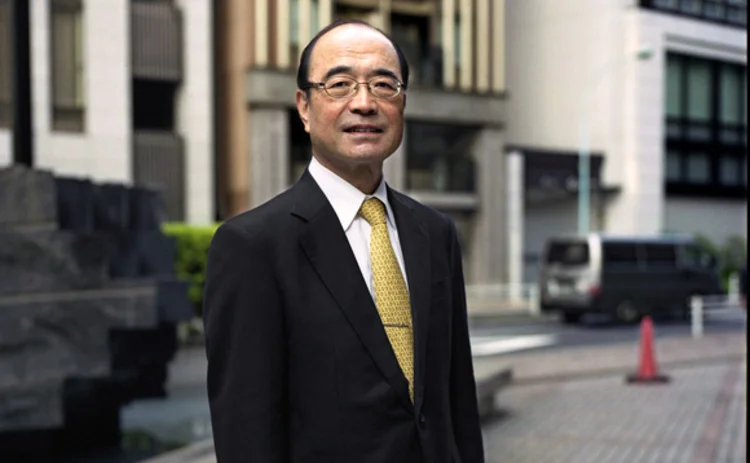
In Japan, it is traditional to work your entire career for one company. While that may be changing, when Yoshinori Suzuki graduated from Tokyo Denki University in 1972, this type of loyalty was certainly the prevailing cultural norm in Tokyo. Suzuki had spent the first 34 years of his career in various roles at Nippon Telegraph & Telephone (NTT), the Japanese telecom behemoth. By 2006 ─ now the president and CEO of NTT Data Force and 57 years old ─ barring a massive round of layoffs, there was no reason to believe that he wouldn’t retire as an employee of NTT.
It was at this time that the Tokyo Stock Exchange (TSE) had experienced several significant IT failures. The exchange operator was embarrassed, its staff demoralized. In need of help, TSE’s then-president Taizo Nishimuro called NTT’s then-president Norio Wada and explained that he was looking for a top candidate from the ranks of NTT to take over the role of CIO at the exchange operator.
NTT had no desire to let Suzuki go, and Suzuki had no desire to leave the company where he began his professional career. But Nishimuro told Wada that it was in NTT’s best interests for the TSE to get its infrastructure in order. After all, a reliable exchange was vital to growing Japan’s economy, and a strong economy is good for NTT’s bottom line.
So, reluctantly, Suzuki was sent to the TSE ─ almost like a baseball player being traded at the tail end of his career after a storied run with his previous team.
“The president of TSE at the time made a request to NTT that they would like to get a CIO candidate from the NTT group,” Suzuki recalls. “[Mr. Wada] told me that this is a big issue for the Japanese economy and NTT group had to help out. He said that TSE was in need of a person who could take on such a big role, and that person was me. But at that time, I had no background on trading systems; I only had experience working with local banks.”
They say that blessings come in disguise, and for Suzuki, the move would lead to the two most exciting projects of his career: the launch of the arrowhead trading platform and overseeing the merger of the TSE’s platforms with that of the Osaka Securities Exchange (OSE).
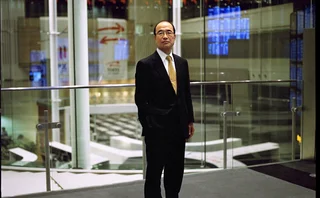
Two Become One
The Tokyo Stock Exchange building is a magnificent piece of architecture. Its exterior is comprised of a coarse granite that sparkles in the sunlight. Its shape is slightly trapezoidal. On the inside, there is a trading floor that looks like it was taken from the set of a Star Trek movie reboot, and certain corridors have an imposing, towering feel.
But all in all, the building is as quiet as a shrine. There aren’t any traders on the floor, save for a handful of people surveying the market, making sure that nothing is out of whack. It’s electronic trading to the highest degree.
Suzuki is sitting in a plush room ─ there’s a mahogany table surrounded by reserved yet finely upholstered cream-white sofas and chairs. He speaks some English, but prefers to conduct this interview in his native Japanese. We are meeting to discuss his career and the path forward for the Japan Exchange Group (JPX), the new name for the newly merged TSE and OSE. Stuart Davis and Natsuho Torii from JPX’s communications department are on hand to translate.
In 2013, the TSE completed its merger with the OSE, making the resulting JPX the third-largest equities market, globally. Suzuki says TSE CEO Atsushi Saito felt that the TSE lagged behind its competitors when it came to the globalization of the company. The TSE didn’t have a strong presence on the world stage and it was weak when it came to its derivatives market, which was a source of strength for Osaka.
“In order to globalize, the first thing that needed to be done was to establish a derivatives market to a certain scale within Japan,” Suzuki says. “Obviously, there’s a difference in the potential growth of equities and derivatives, and because we believe there’s greater potential for growth of derivatives than equities, Mr. Saito did not believe that the exchange system would sustain itself with just equities alone.”
As with most mergers, the primary challenge was deciding which platforms to use, and what should be ditched. The TSE arrowhead platform was tapped for equities trading. For derivatives, the exchange went with J-Gate, which the OSE had adopted from Nasdaq OMX. For clearing, JPX decided on the Japan Securities Clearing Corporation (JSCC) Clearing System.
With these decisions made, though, JPX also announced in February that it was looking to invest in a new derivatives trading system and issued a request for proposal (RFP).
“In March 2014 we integrated the derivatives system to J-Gate, but it was a generation older and used a system called the Clicks System, which limits the type of server that can be used,” Suzuki says. “Based on this, JPX began to construct a next generation derivatives trading system. The development of this system will aim to produce a highly convenient and globally competitive system, which will serve the derivatives market for the medium-to-long-term future.”
Prior to the arrowhead build, TSE executives went to New York, Chicago and London to see how a variety of platforms worked. Suzuki visited NYSE Euronext in March and has also visited the exchanges in Hong Kong and Australia.
In July 2013, JPX consolidated its equity marketplaces, and in March 2014, the derivatives markets were merged under one platform. Kazumitsu Yokokawa, division manager of financial services and technology at Tokyo-based consultancy NRI, explains that brokers and institutional traders will benefit most from having a consolidated system, rather than having to use two different platforms. Additionally, through these consolidations, JPX executives believe they will be able to realize a ¥7 billion ($70 million) reduction in “annual cost synergies,” which can be passed on to new products and global expansion, he adds.
“A single central clearing facility for derivatives benefits traders as they can reduce margin costs,” Yokokawa says. “JPX can reduce the duplicated system costs and operation costs, and can focus more on new product development and create a competitive market place globally.”
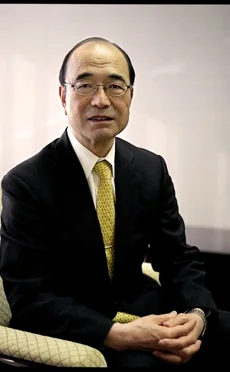
Straight as an Arrow
Soon after Suzuki joined the TSE in 2006, plans for arrowhead went into full effect. At the time, the TSE had an order response time of two to three seconds, according to Suzuki. Under arrowhead, the average order response time has been cut to about 1 millisecond, with a data distribution time of about 2 to 2.5 milliseconds.
At this year’s Tokyo Trading Architecture Summit, Hiroshi Matsubara, co-chair of the Japan FIX Protocol Ltd. (FPL) Regional Committee, said that with arrowhead he feels the Japanese market has already caught up with other regions from a technology standpoint, and now the challenge is gaining the market knowledge as to how to best utilize low-latency trading strategies.
“In the Japanese market, when we consider the electronic trading systems, we are progressing to a certain extent in terms of the innovation, and we may be on par with the other markets when it comes to low-latency trading and high-frequency trading, as well as algorithmic transactions and order routing,” Matsubara said through a translator. “We do have the hardware in place already, but there ought to be some change of the mindset for the regulators and participants to make it functional and to change market customs. These are soft areas-areas where Japan is still lagging behind in terms of innovation. There’s a lack of knowledge on the sell side and institutional investors are not well-versed in how to use these innovative systems.”
If it is the case that these firms lag financial services firms in the West when it comes to how best to use these systems, they will need to catch up in a hurry. Suzuki and his team are not sitting on their laurels. The largest project they are working on is the renewal of the arrowhead platform, scheduled to launch sometime between July and September next year, he says.
Included in the upgrade are a bevy of risk management functions and more sophisticated kill switches. Capacity will also be key. Consider that in 2010, the average number of orders per day was 8.2 million-in 2013, that number rocketed to 18 million, and will continue to rise. JPX will add sub-yen tick sizes, and, as a result, the exchange will need to expand arrowhead’s processing capacity in order to grow to 270 million orders per day.
But curtailing risk will be front and center as electronic trading continues to expand in the region. In what could be dubbed “arrowhead 2.0,” Suzuki feels that JPX can serve as a model for other exchanges, in keeping with the company’s desire to expand its global influence. He is proud of JPX’s trade rules that have been implemented in light of the Flash Crash and other trading spikes that have happened around the world.
“The rules for trading at the TSE are strict when it comes to the management of price fluctuations,” Suzuki says. “For example, if there’s a certain movement in prices, there are rules in place to halt trading temporarily to allow account orders to still come in and prevent rapid fluctuations. We believe this is a very effective way to predict rapid price fluctuations.” JPX plans to bolster those capabilities with arrowhead’s successor.
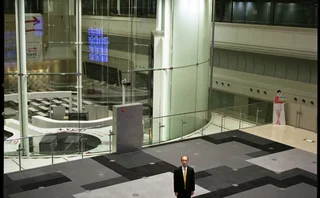
Not Yet Into the Sunset
There was a time when Suzuki envisioned that he would conclude his professional career as an NTT man. But that is not how his life played out. Call it fate or luck or HR intervention, but Suzuki ended up at the TSE at the perfect time-a time of great strife, but also at a time when the appetite for future success was insatiable and the need for change undeniable.
Because Suzuki lacked trading experience, the move to the TSE was jarring. When he joined the exchange operator, the team he inherited was battered from a volley of highly public verbal and written assaults. Suzuki has overseen some impressively large project rollouts in his relatively brief time ─ by Japanese standards, anyway ─ at JPX, but perhaps his most impressive feat was restoring the confidence of his new team.
“At the time the TSE engineers went through a lot of trouble and that resulted in public bashing and complaints, and many of them lost confidence; so I had to build their confidence,” he recalls. “The individual worker may not have enough strength, but if everyone came and worked together, that would bring strength and confidence. So building strength in them to overcome the problems they were having was my next big job.
“There were failures, but what happened, happened-you can’t go back and change that,” he continues. “So, after accepting what had happened was in the past, we then had to solve the problem together. That is the first thing to think about and we had to succeed at that.”
With confidence restored, a merger recently completed, and a derivatives overhaul and arrowhead upgrade imminent, now is the time for yet another forward push-and for these initiatives Suzuki is now well-versed in trading platforms. While he wasn’t exactly “traded” to the TSE from NTT, Suzuki has proven to be quite an acquisition.
(Note: A recording of this interview was also transcribed by Hiromi Shibuya.)
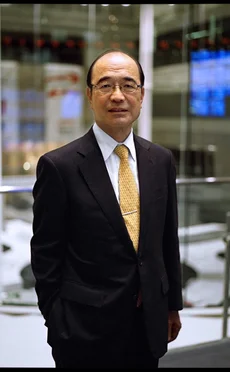
Fundamental Data
Name: Yoshinori Suzuki
Age: 65
Title: CIO and executive vice president of JPX and senior managing director of the TSE
Education: Bachelor’s degree in engineering from Tokyo Denki University in March 1972
Almost a Carpenter: Before college, Suzuki worked with his family making wooden barrels called Oke. He almost followed that path as his professional career, but decided to take on electrical engineering instead, although he is still good with his hands. “I used to shave and carve wood and I am still really good at working with it,” he says.
Only users who have a paid subscription or are part of a corporate subscription are able to print or copy content.
To access these options, along with all other subscription benefits, please contact info@waterstechnology.com or view our subscription options here: http://subscriptions.waterstechnology.com/subscribe
You are currently unable to print this content. Please contact info@waterstechnology.com to find out more.
You are currently unable to copy this content. Please contact info@waterstechnology.com to find out more.
Copyright Infopro Digital Limited. All rights reserved.
You may share this content using our article tools. Printing this content is for the sole use of the Authorised User (named subscriber), as outlined in our terms and conditions - https://www.infopro-insight.com/terms-conditions/insight-subscriptions/
If you would like to purchase additional rights please email info@waterstechnology.com
Copyright Infopro Digital Limited. All rights reserved.
You may share this content using our article tools. Copying this content is for the sole use of the Authorised User (named subscriber), as outlined in our terms and conditions - https://www.infopro-insight.com/terms-conditions/insight-subscriptions/
If you would like to purchase additional rights please email info@waterstechnology.com
More on Emerging Technologies
Waters Wavelength Podcast: Broadridge’s Joseph Lo on GPTs
Joseph Lo, head of enterprise platforms at Broadridge, joins the podcast to discuss AI tools.
Man Group CTO eyes ‘significant impact’ for genAI across the fund
Man Group’s Gary Collier discussed the potential merits of and use cases for generative AI across the business at an event in London hosted by Bloomberg.
BNY Mellon deploys Nvidia DGX SuperPOD, identifies hundreds of AI use cases
BNY Mellon says it is the first bank to deploy Nvidia’s AI datacenter infrastructure, as it joins an increasing number of Wall Street firms that are embracing AI technologies.
This Week: Linedata acquires DreamQuark, Tradeweb, Rimes, Genesis, and more
A summary of some of the latest financial technology news.
Systematic tools gain favor in fixed income
Automation is enabling systematic strategies in fixed income that were previously reserved for equities trading. The tech gap between the two may be closing, but differences remain.
Euronext microwave link aims to cut HFT advantage in Europe
Exchange plans to level playing field between prop firms and banks in cash equities with cutting edge tech.
Why recent failures are a catalyst for DLT’s success
Deutsche Bank’s Mathew Kathayanat and Jie Yi Lee argue that DLT's high-profile failures don't mean the technology is dead. Now that the hype has died down, the path is cleared for more measured decisions about DLT’s applications.
‘Very careful thought’: T+1 will introduce costs, complexities for ETF traders
When the US moves to T+1 at the end of May 2024, firms trading ETFs will need to automate their workflows as much as possible to avoid "settlement misalignment" and additional costs.
Most read
- Chris Edmonds takes the reins at ICE Fixed Income and Data Services
- Deutsche Börse democratizes data with Marketplace offering
- Sell-Side Technology Awards 2024: All the winners








